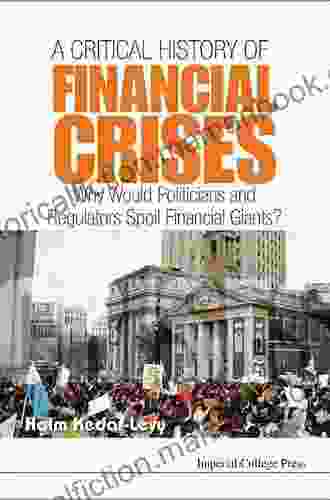A Critical History of Financial Crises: From Tulipmania to the Global Financial Crisis

Financial crises have been a recurring feature of the global economy for centuries. They have caused widespread economic damage, social unrest, and political instability. The Global Financial Crisis of 2008, the most recent in a long line of crises, was the most severe since the Great Depression of the 1930s. It led to a sharp decline in global output, rising unemployment, and a loss of confidence in the financial system.
The Global Financial Crisis has prompted a great deal of research into the causes and consequences of financial crises. This research has helped to improve our understanding of these events, but it has also raised some important questions. One of the most important questions is whether financial crises are simply isolated events, or whether they are part of a long-term pattern of financial instability.
This article provides a critical history of financial crises, from the Tulipmania of the 17th century to the Global Financial Crisis of 2008. It explores the causes, consequences, and policy responses to these crises, and argues that they are not simply isolated events, but rather part of a long-term pattern of financial instability.
5 out of 5
| Language | : | English |
| File size | : | 6622 KB |
| Text-to-Speech | : | Enabled |
| Screen Reader | : | Supported |
| Enhanced typesetting | : | Enabled |
| Word Wise | : | Enabled |
| Print length | : | 226 pages |
The Tulipmania was a speculative bubble that occurred in the Netherlands in the 1630s. It was the first recorded financial crisis in history. The bubble was caused by a combination of factors, including the popularity of tulips as a luxury item, the development of a futures market for tulips, and low interest rates.
The price of tulips rose rapidly in the 1630s, and by 1637, a single tulip bulb could be worth more than a house. The bubble burst in February 1637, and the price of tulips collapsed. Many people who had invested in tulips lost their entire fortunes.
The Tulipmania was a classic example of a speculative bubble. It was driven by greed and speculation, and it ended in a crash. The Tulipmania is a reminder that financial bubbles can occur in any asset class, and that they can have devastating consequences.
The South Sea Bubble was a speculative bubble that occurred in England in the 1720s. It was the second recorded financial crisis in history. The bubble was caused by a combination of factors, including the popularity of the South Sea Company as a speculative investment, the development of a futures market for South Sea stock, and low interest rates.
The price of South Sea stock rose rapidly in the 1720s, and by 1720, a single share of South Sea stock was worth more than £1,000. The bubble burst in September 1720, and the price of South Sea stock collapsed. Many people who had invested in South Sea stock lost their entire fortunes.
The South Sea Bubble was a classic example of a speculative bubble. It was driven by greed and speculation, and it ended in a crash. The South Sea Bubble is a reminder that financial bubbles can occur in any asset class, and that they can have devastating consequences.
The Global Financial Crisis was the most severe financial crisis since the Great Depression of the 1930s. It began in the United States in 2007, and it quickly spread to the rest of the world. The crisis was caused by a combination of factors, including the subprime mortgage crisis, the collapse of the housing bubble, and the failure of several major financial institutions.
The Global Financial Crisis led to a sharp decline in global output, rising unemployment, and a loss of confidence in the financial system. The crisis had a profound impact on the global economy, and it is still being felt today.
The Global Financial Crisis was a classic example of a financial crisis. It was caused by a combination of excessive risk-taking, lax regulation, and government intervention. The crisis is a reminder that financial crises can have devastating consequences, and that they can occur even in the most advanced economies.
Financial crises are caused by a complex combination of factors. However, some of the most common causes include:
- Excessive risk-taking: Financial crises are often caused by excessive risk-taking by banks and other financial institutions. This risk-taking can take many forms, such as lending to risky borrowers, investing in risky assets, or using excessive leverage.
- Lax regulation: Financial crises are often caused by lax regulation of the financial industry. This can allow banks and other financial institutions to take on excessive risks without facing adequate consequences.
- Government intervention: Financial crises are often caused by government intervention in the financial markets. This intervention can take many forms, such as bailing out failing banks, providing guarantees for risky loans, or setting interest rates at artificially low levels.
Financial crises can have a wide range of negative consequences, including:
- Economic damage: Financial crises can cause a sharp decline in economic activity. This can lead to widespread unemployment, falling incomes, and a decline in living standards.
- Social unrest: Financial crises can lead to social unrest as people lose their jobs, homes, and savings. This can lead to protests, riots, and even political instability.
- Loss of confidence: Financial crises can lead to a loss of confidence in the financial system. This can make it difficult for businesses to borrow money and invest, which can further slow economic growth.
Governments have a variety of policy tools at their disposal to respond to financial crises. These tools include:
- Monetary policy: Monetary policy can be used to influence interest rates and the supply of money in the economy. This can be used to stimulate economic growth and prevent financial crises from escalating.
- Fiscal policy: Fiscal policy can be used to influence the level of government spending and taxation. This can be used to stimulate economic growth and support financial institutions during a crisis.
- Regulation: Regulation can be used to limit the risks that banks and other financial institutions can take. This can help to prevent financial crises from occurring in the first place.
Financial crises are a recurring feature of the global economy. They can have devastating consequences, including economic damage, social unrest, and loss of confidence in the financial system. The Global Financial Crisis of 2008 was the most severe financial crisis since the Great Depression of the 1930s. It is a reminder that financial crises can occur even in the most advanced economies.
Governments have a variety of policy tools at their disposal to respond to financial crises. These tools include monetary policy, fiscal policy, and regulation. However, there is no one-size-fits-all solution to financial crises. The best approach will vary depending on the specific circumstances of each crisis.
One of the most important lessons that we can learn from financial crises is that they are not simply isolated events. They are part of a long-term pattern of financial instability
5 out of 5
| Language | : | English |
| File size | : | 6622 KB |
| Text-to-Speech | : | Enabled |
| Screen Reader | : | Supported |
| Enhanced typesetting | : | Enabled |
| Word Wise | : | Enabled |
| Print length | : | 226 pages |
Do you want to contribute by writing guest posts on this blog?
Please contact us and send us a resume of previous articles that you have written.
 Top Book
Top Book Novel
Novel Fiction
Fiction Nonfiction
Nonfiction Literature
Literature Paperback
Paperback Hardcover
Hardcover E-book
E-book Audiobook
Audiobook Bestseller
Bestseller Classic
Classic Mystery
Mystery Thriller
Thriller Romance
Romance Fantasy
Fantasy Science Fiction
Science Fiction Biography
Biography Memoir
Memoir Autobiography
Autobiography Poetry
Poetry Drama
Drama Historical Fiction
Historical Fiction Self-help
Self-help Young Adult
Young Adult Childrens Books
Childrens Books Graphic Novel
Graphic Novel Anthology
Anthology Series
Series Encyclopedia
Encyclopedia Reference
Reference Guidebook
Guidebook Textbook
Textbook Workbook
Workbook Journal
Journal Diary
Diary Manuscript
Manuscript Folio
Folio Pulp Fiction
Pulp Fiction Short Stories
Short Stories Fairy Tales
Fairy Tales Fables
Fables Mythology
Mythology Philosophy
Philosophy Religion
Religion Spirituality
Spirituality Essays
Essays Critique
Critique Commentary
Commentary Glossary
Glossary Bibliography
Bibliography Index
Index Table of Contents
Table of Contents Preface
Preface Introduction
Introduction Foreword
Foreword Afterword
Afterword Appendices
Appendices Annotations
Annotations Footnotes
Footnotes Epilogue
Epilogue Prologue
Prologue James Bamford
James Bamford Jeff John
Jeff John Miranda Doerfler
Miranda Doerfler Frederick Moehn
Frederick Moehn Catalina Dubois
Catalina Dubois Kate Sedley
Kate Sedley Amina Akhtar
Amina Akhtar Elizabeth Williamson
Elizabeth Williamson Tasha Squires
Tasha Squires Robert David Steele Vivas
Robert David Steele Vivas Amy Leu
Amy Leu J L Beck
J L Beck Ramon Henson
Ramon Henson Jay Parkes
Jay Parkes Eivor Martinus
Eivor Martinus Susan Alexander Yates
Susan Alexander Yates Robert J Bannon
Robert J Bannon Kaiden Emerald
Kaiden Emerald Deborah Harkness
Deborah Harkness The Moth
The Moth
Light bulbAdvertise smarter! Our strategic ad space ensures maximum exposure. Reserve your spot today!
 Edwin BlairFollow ·6.6k
Edwin BlairFollow ·6.6k Italo CalvinoFollow ·6.3k
Italo CalvinoFollow ·6.3k Finn CoxFollow ·8.4k
Finn CoxFollow ·8.4k Jack PowellFollow ·18.8k
Jack PowellFollow ·18.8k Brayden ReedFollow ·13.1k
Brayden ReedFollow ·13.1k Jesse BellFollow ·10.9k
Jesse BellFollow ·10.9k Cason CoxFollow ·5k
Cason CoxFollow ·5k Devin RossFollow ·3.9k
Devin RossFollow ·3.9k

 Allen Ginsberg
Allen GinsbergUnlocking Financial Peace with Low Risk Investing: A...
In the world of investing, it is often said...

 Eddie Powell
Eddie PowellLoop of Jade: An Exploration of Grief, Memory, and the...
Sarah Howe's...

 Zachary Cox
Zachary CoxHealth Benefits in Retirement: Navigating the Maze of...
Retirement...
5 out of 5
| Language | : | English |
| File size | : | 6622 KB |
| Text-to-Speech | : | Enabled |
| Screen Reader | : | Supported |
| Enhanced typesetting | : | Enabled |
| Word Wise | : | Enabled |
| Print length | : | 226 pages |


















